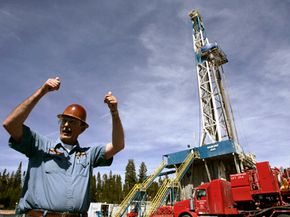How Does Geothermal Compare to Other Energy Sources?
Experts say geothermal energy is cleaner, more efficient, and more cost-effective than burning fossil fuels, and it can reduce our dependence on foreign oil.
Geothermal energy is clean because it can be generated without burning fossil fuels. Geothermal plants release a fraction of the carbon dioxide produced by fossil fuel plants, and they create very little nitrous oxide or sulfur gases [source: U.S. Department of Energy]. Reykjavik, Iceland, which heats 95 percent of its buildings using geothermal energy, is considered one of the cleanest cities in the world [source: International Geological Congress Oslo].
Advertisement
Because the energy is generated right near the plant, it saves on processing and transportation costs compared to other types of fuel. Geothermal plants are also considered to be more reliable than coal or nuclear plants because they can run consistently, 24 hours a day, 365 days a year.
The initial costs of geothermal energy are high -- wells can cost $1 to $4 million each to drill, and installation of a home geothermal pump system can run as much as $30,000 [sources: REPP, Consumer Energy Center]. However, a home geothermal energy pump can cut energy bills by 30 to 40 percent and will pay for itself within 5 to 10 years [source: Consumer Energy Center].
Geothermal energy is considered renewable because the heat is continually replaced. The water that is removed is put right back into the ground after its heat is used.
The world uses about 7,000 megawatts of geothermal energy, about 2,700 megawatts of which is produced in the United States (the equivalent of burning 60 million barrels of oil each year) [source: Geothermal Education Office]. Still, we're not using nearly as much geothermal energy as is available. That has to do with the limited geographic availability of geothermal energy, and the difficulty and expense of drilling down far enough to reach that energy. More advanced techniques being developed could allow for deeper drilling, potentially bringing geothermal energy to more people in more places.
For right now, geothermal heat pumps are the most viable option. They can be used just about anywhere in the world because the temperature beneath the ground always remains constant.
Related HowStuffWorks Articles
More Great Links
Sources
- Consumer Energy Center. "Geothermal Energy." (Feb. 2, 2009) http://www.consumerenergycenter.org/renewables/geothermal/directuse.html
- Energy Information Administration. Energy Kid's Page. (Feb. 2, 2009) http://www.eia.doe.gov/kids/energyfacts/sources/renewable/geothermal.html
- Geothermal Education Office. "Geothermal Energy Facts." (Feb. 2, 2009) http://geothermal.marin.org/pwrheat.html
- Geothermal Energy Association. "All About Geothermal Energy -- Basics." (Feb. 2, 2009) http://www.geo-energy.org/aboutGE/currentUse.asp
- Howden, Daniel. "World energy supplies are set to run out faster than expected, warn scientists." The Independent. June 14, 2007. (Feb. 7, 2009) http://www.independent.co.uk/news/science/world-oil-supplies-are-set-to-run- out-faster-than-expected-warn-scientists-453068.html
- REPP. Geothermal Resources. (Feb. 2, 2009) http://repp.org/geothermal/geothermal_brief_geothermal_resources.html
- "Underground Heat." Canada and the World Backgrounder. October 1999, pgs. 21-25.
- U.S. Department of Energy, Geothermal Technologies Program. "Geothermal Basics." (Feb. 2, 2009) http://www1eere.energy.gov/geothermal/geothermal_basics.html
- Worden, Jessica. "Clean Heat: The Geothermal Energy Beneath Our Feet." House & Home. January/February 2005, Volume 16, Issue 1, pgs. 44-45.
